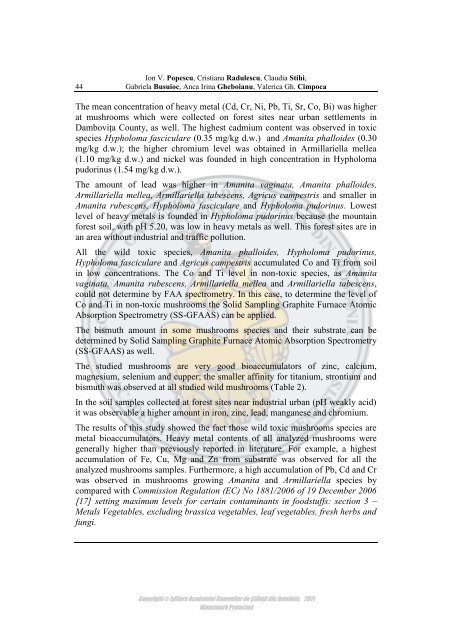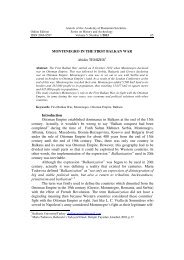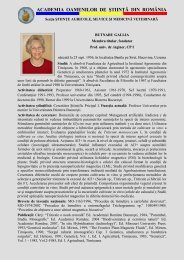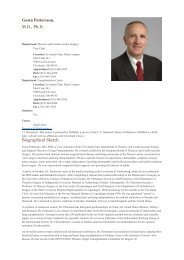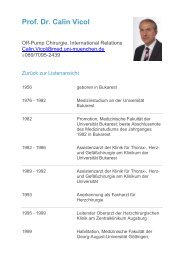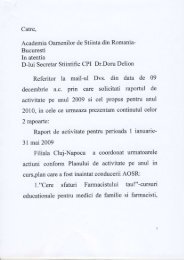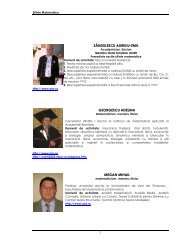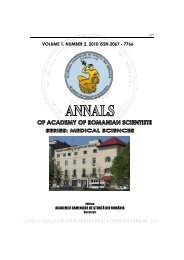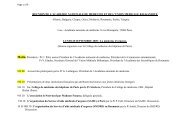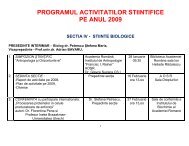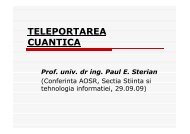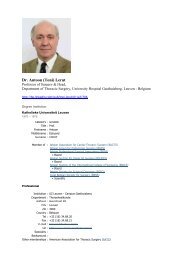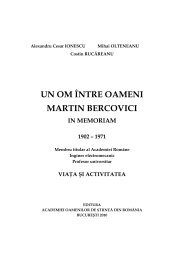Volume 3 nr 1 / 2011 - Academia Oamenilor de Stiinta din Romania
Volume 3 nr 1 / 2011 - Academia Oamenilor de Stiinta din Romania
Volume 3 nr 1 / 2011 - Academia Oamenilor de Stiinta din Romania
- No tags were found...
Create successful ePaper yourself
Turn your PDF publications into a flip-book with our unique Google optimized e-Paper software.
Ion V. Popescu, Cristiana Radulescu, Claudia Stihi,44 Gabriela Busuioc, Anca Irina Gheboianu, Valerica Gh. CimpocaThe mean concentration of heavy metal (Cd, Cr, Ni, Pb, Ti, Sr, Co, Bi) was higherat mushrooms which were collected on forest sites near urban settlements inDambovița County, as well. The highest cadmium content was observed in toxicspecies Hypholoma fasciculare (0.35 mg/kg d.w.) and Amanita phalloi<strong>de</strong>s (0.30mg/kg d.w.); the higher chromium level was obtained in Armillariella mellea(1.10 mg/kg d.w.) and nickel was foun<strong>de</strong>d in high concentration in Hypholomapudorinus (1.54 mg/kg d.w.).The amount of lead was higher in Amanita vaginata, Amanita phalloi<strong>de</strong>s,Armillariella mellea, Armillariella tabescens, Agricus campestris and smaller inAmanita rubescens, Hypholoma fasciculare and Hypholoma pudorinus. Lowestlevel of heavy metals is foun<strong>de</strong>d in Hypholoma pudorinus because the mountainforest soil, with pH 5.20, was low in heavy metals as well. This forest sites are inan area without industrial and traffic pollution.All the wild toxic species, Amanita phalloi<strong>de</strong>s, Hypholoma pudorinus,Hypholoma fasciculare and Agricus campestris accumulated Co and Ti from soilin low concentrations. The Co and Ti level in non-toxic species, as Amanitavaginata, Amanita rubescens, Armillariella mellea and Armillariella tabescens,could not <strong>de</strong>termine by FAA spectrometry. In this case, to <strong>de</strong>termine the level ofCo and Ti in non-toxic mushrooms the Solid Sampling Graphite Furnace AtomicAbsorption Spectrometry (SS-GFAAS) can be applied.The bismuth amount in some mushrooms species and their substrate can be<strong>de</strong>termined by Solid Sampling Graphite Furnace Atomic Absorption Spectrometry(SS-GFAAS) as well.The studied mushrooms are very good bioaccumulators of zinc, calcium,magnesium, selenium and cupper; the smaller affinity for titanium, strontium andbismuth was observed at all studied wild mushrooms (Table 2).In the soil samples collected at forest sites near industrial urban (pH weakly acid)it was observable a higher amount in iron, zinc, lead, manganese and chromium.The results of this study showed the fact those wild toxic mushrooms species aremetal bioaccumulators. Heavy metal contents of all analyzed mushrooms weregenerally higher than previously reported in literature. For example, a highestaccumulation of Fe, Cu, Mg and Zn from substrate was observed for all theanalyzed mushrooms samples. Furthermore, a high accumulation of Pb, Cd and Crwas observed in mushrooms growing Amanita and Armillariella species bycompared with Commission Regulation (EC) No 1881/2006 of 19 December 2006[17] setting maximum levels for certain contaminants in foodstuffs: section 3 –Metals Vegetables, exclu<strong>din</strong>g brassica vegetables, leaf vegetables, fresh herbs andfungi.Copyright © Editura Aca<strong>de</strong>miei <strong>Oamenilor</strong> <strong>de</strong> Știință <strong>din</strong> România, <strong>2011</strong>Watermark Protected


